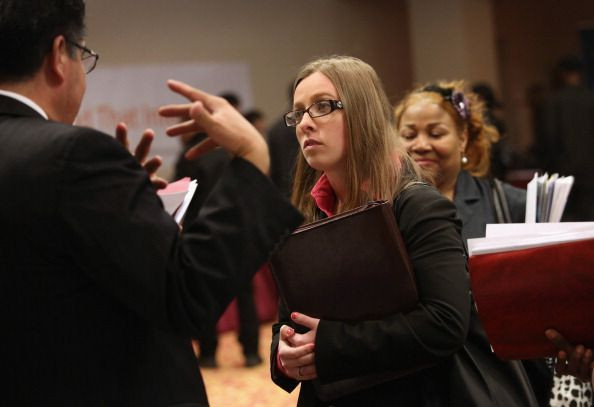US November Jobs Report 2013: Unemployment Rate Falls To 7.0%, Nonfarm Payrolls Rise By 203k

U.S. job growth remained solid in November and the unemployment rate fell to the lowest level in five years, a sign of stronger economic growth that could bring the Federal Reserve a step closer to curtailing its massive monetary stimulus.
Despite Friday’s surprisingly strong report, some economists believe there are good reasons that the Fed is unlikely to pull the trigger at the Dec. 17-18 policy meeting. The central bank probably wants more data in hand to be sure that the job gains are sustainable and wants to make sure lawmakers on Capitol Hill can strike a deal on the government budget in January.
“My guess is that they will wait one more month,”Gus Faucher, senior economist at PNC Financial Services, said. “I think they want to get one more month of data and they’ll wait and make sure that Congress is getting its act together before the Fed makes a decision to reduce purchases.”
Employers added 203,000 jobs in November, higher than the 180,000 Wall Street anticipated. September and October payroll numbers were revised up by a combined 8,000.
Payroll growth is on track for the best year since 2005. U.S. businesses added more than 186,000 jobs a month on average so far in this year, compared with 182,750 in 2012.
The unemployment rate fell to 7.0 percent, the lowest level since November 2008, while economists expected the rate to fall less to 7.2 percent.
“The numbers in the household survey has been skewed over the past couple of months by the government shutdown, but the fact that the unemployment rate fell to 7 percent is a strong, positive indication that the labor market continues its improvement,” Faucher said.
“The fundamentals of the economy look pretty solid and the improvement in the job market is a reflection of that,” Faucher added. “Business profits are at record highs, consumer balance sheets are in very good shape, they’ve paid down a lot of debt. We are seeing a recovery in the housing market and businesses are investing.”
On Thursday, the Commerce Department said the U.S. economy grew at an annualized rate of 3.6 percent in the third quarter. Meanwhile, the Bureau of Economic Analysis reported that as a percentage of GDP, corporate profits reached a record of 10.8 percent. Compared to national income, profits are nearly at a record, at 11.7 percent.
“We are getting into a situation where the job gains are enough to power consumer spending growth and we are getting into a positive self-reinforcing cycle there,” Faucher said.
The improvement in job growth has been broad-based, with gains for transportation and warehousing, health care, manufacturing, retail and construction.
Private companies added 196,000 jobs in November, accounting for most of the month's gains. Manufacturers added 27,000 jobs last month, the best month since March 2012.
Federal government employment fell by 7,000 last month, but that was more than offset by increased hiring at the state and local level.
Friday's report also said that average earnings rose by 4 cents to $24.15 an hour, while the average workweek increased 0.1 hour to 34.5 hours.
The Fed's Dilemma
The unemployment rate has fallen steadily from a peak of 10.0 percent in late 2009, to 7.0 percent in November.
When the Fed launched the third round of quantitative easing, or QE3, just over a year ago, officials expected the unemployment rate to be between 7.6 percent and 7.9 percent in the final quarter of this year. The rate wasn't expected to get down to 7.0 percent until the final quarter of 2014.
Since the decline in the unemployment rate has been so much bigger than originally expected, it might seem strange that the Fed is still reluctant to begin winding down its quantitative easing.
“The dilemma facing the Fed is that the unemployment rate has been falling not just because employment has been rising, but also because people are leaving the active labor force,” Paul Ashworth, of Capital Economics, said.
The labor force participation rate, which measures the proportion of the population either working or looking for work during the month, dropped to a 35-year low of 62.8 percent in October before ticking up to 63 percent in November.
This has forced Fed officials to radically revise their thinking. By September, when the Fed unexpectedly opted not to slow the pace of its asset purchases, Chairman Ben Bernanke was warning that “the unemployment rate is not necessarily a great measure in all circumstances of the state of the labor market overall" and, consequently, "there is not any magic number that we are shooting for.”
Fed officials are considering whether they should amend their existing forward guidance, which pledges to leave the fed funds rate at near zero until the unemployment rate falls to 6.5 percent or lower. Minneapolis Fed President Narayana Kocherlakota has suggested cutting the so-called threshold level to 5.5 percent.
“The push by officials to delay tapering its asset purchases and possibly to lower its unemployment rate threshold suggests that the Fed expects the participation rate to rebound,” Ashworth said, adding that he expects the aging of the population will drive the participation rate even lower over the next five years.
“If we are right, the Fed might eventually find itself in a bind, as real earnings growth begins to pick up while it is still committed to leaving interest rates at near zero,” Ashworth said. “As a result, the Fed would be forced to choose between risking its credibility by raising rates more aggressively than it is currently suggesting or allowing inflation to climb above the 2 percent target.”
© Copyright IBTimes 2025. All rights reserved.






















